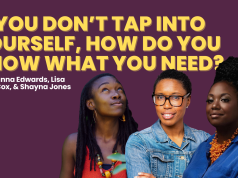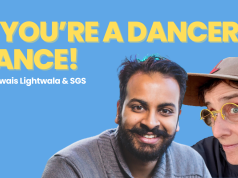Inclusion: Building a Culture of Desire and Resilience
By Alex Bulmer
On February 15, a day rumoured to be colder than the North Pole, a crowd of people filled the Queen West Theatre Centre to participate in a conversation event called The Republic of Inclusion. The audience, a range of academics, theatre makers, community activists and educators arrived on foot, wheels, with guide dogs and sticks.
The event raised the profile of inclusion, particularly inclusion in the performing arts. It offered examples of audience access (relaxed performances, audio description, real time and ASL communication), touched on the process of creating from differing mental health, sensory or neurological perspectives and offered people the chance to consider how we design our participatory spaces to include people with differing physical and communication priorities.
Despite some of the obvious reasons to feel positive about the event, the truth of my experience was mixed; at times I felt invigorated and hopeful and at times frustrated and somewhat in despair.
I was one of the co-curators of the event. What I brought to the creation of the Republic comes from over twenty years of experience as a theatre professional, and a similar number of years gradually becoming blind.
My experience of functioning while blind has both a Canadian and a European context. In 2004 after 12 years of living and working as a self-employed theatre artist in Canada, I left Toronto for the United Kingdom. A prime motivator for my exit was the UK’s developed participation in the performing arts, coupled with a cultural understanding of disability informed by a social rather than medical perspective.
England has a robust disability legislation that is enforced both locally and nationally (unlike the Ontarians with Disabilities Act which was then non-existent and is currently toothless and unenforced). England also makes access related public funding available to all working disabled people, enabling me and thousands of others a dignity of work and life.
One such funding scheme is a highly respected national programme called Access to Work. This directly supports a disabled person in working by covering costs related to their particular and specific access needs. When, for example, I work in a theatre or film environment in the UK, I am enabled by the Access to Work fund to employ a support worker for mobility support, line feeding, or description of action. Support costs are claimed by me and I am refunded on a monthly basis. Without this, I could not effectively manage or direct the support I need, or sustain a cash flow to afford it. My success in the UK and that of others such as the Republic’s fantastic keynote speaker, Jess Thom, is directly affected by this system of support.
The national pride for Access to Work in the UK recently roared when the scheme was put under government review. The public demanded the funds be protected and proposed that disabling people from the right to manage their own support, or entrapping individuals who possess the potential to work with an inability to employ flexible access systems, was “oppressive”, “discriminatory” and “amoral”. For those who could merely understand value with pound signs in their eyes, the economics of the scheme were made public: for every pound invested by the Treasury, there was one pound fifty returned.
The UK is not the exception. Other European and developed countries hold a similar standard of human rights regarding inclusion and employment. These countries benefit from a citizenship with engaged and creative people who identify as disabled and also identify as entrepreneurs, professional actors, directors, teachers, curators, producers, consultants, dancers, photographers, journalists,and broadcasters . They all are liberated by the cultural and political systems that support and empower participation, employment and dignity.
For me, my twelve years in Europe has given me transformative insight.
It’s possible to be blind and not dis-abled from creative and rewarding work; it’s possible to be blind and not dis–empowered by government policies; it’s very very possible to be blind and not dis-appointed in life.
Canada does not have a national policy or scheme giving the right to a disabled person in work to manage flexible support, or be directly reimbursed for access costs. This is a disaster for anyone wishing to pursue an artistic or self-employed freelance profession. As a result, many people, including myself, can’t function well in Ontario – a fact that does disable, disempower and disappoint.
And so I feel frustrated. And impatient. And desperate. I’ve been exposed to real inclusion and I don’t wish to settle any longer for any less. Yes, I have escaped the dark and seen the light (excuse the visual metaphor).
And I will fight. As do many others. At minimum to maintain a sense of dignity despite the battles. At best, to build Canadian communities for change.
As evidenced above, I frequently use the term disabled without hesitation. I do so respectful of the fact that not everyone embraces this word, and we all need to choose our language of identity. I choose the word as a statement of political pressure – as a reminder of the barriers that continue to exist and disable access to inclusion. This ‘reminder’ holds the values outlined by the social model of disability rather than the medical model. In a nutshell, the social model indicates that people encounter disabling experiences not due to a medical condition, but as a result of social conditions: environments, attitudes, legislation, political systems and economic values, all of which can exclude.
The disabling experience is therefore a function of the culture one inhabits. My experience of this is crystal clear. I experience being blind very differently in the UK than I do in Canada. It hurts that my home city is where I encounter being increasingly disabled.
The truth is I am comfortable and accept being blind, but I do not accept being repeatedly disabled.
The truth is I am always blind, but I am not always disabled.
The truth is that the social model of inclusion is not just good for some; it’s good for everyone. It creates an enabling culture unafraid of needs and open to the values of inter-dependence. It promotes the best fit based on something other than a hierarchy of the body.
And what has any of this got to do with The Republic of Inclusion held on February 15, 2015 in Toronto? It helps me to understand why I felt such conflicting emotions during the event. It helps me to accept that within the larger positive picture of the day, I sometimes felt negative.
After time to reflect, I can embrace just how desperate I felt to get to a conversation about change. To push forward access to the arts, techniques for audience inclusion (touch tours, description, integrated access), inclusive casting, disability informed art; to find out who cares about cultural inclusion, and what’s so important about it anyway. I wanted to have this discussion whether at
a table or on the floor or on my knees.
With so much exposure to inclusive practice in the UK, contrasted with so little yet in practice in Toronto, I felt, as I often do in Canada, like a pulled sling shot held permanently back in a grip.
I probably secretly wished (as I’m sure others do) that we don’t need to have these strategic discussions. Oh, if only we could come together to celebrate all the ongoing achievements of an inclusive theatre community, an arts culture evolving beyond old patterns of body hierarchy. But – note to self – to desire such progress needs strategies, collective efforts and lip-biting resilience. It also needs the courage to have moments of failure. It has made me think about desire and resilience and failure and what any of this has to do with inclusion.
It brought my thoughts back to a similar design puzzle and inclusion conversation I encountered while advising a London architectural firm. I was asked for design advice for an entrance buzzer to a building being constructed for a disabled led theatre company. There was a realization from the architects that for wheelchair users and people of short stature, the buzzer would be best placed no higher than 100 centimeters. For a blind adult, however, this low level would be totally unfamiliar, and would be best placed much higher.
The architects were fascinated by this design dilemma. The solution seemed obvious to me. I focused on the ultimate goal to be inside the building. I imagined myself returning to the entrance on multiple occasions and suggested they think about the second visit in order to make a design decision. Blindness is a familiarity sensitive impairment, and once a blind person learns information after an initial exploration (in this case that the buzzer is lower than expected), they can choose to bend down on a second visit. A wheelchair user is hardly going to suddenly jump up on a return trip.
Thinking about the event in Toronto, I realize that my advice to the architects highlights the role of desire and resilience in creating inclusion. In the buzzer scenario, I was assuming the blind person, such as myself, would have a desire to enter the building, stronger than any frustration at the entrance. If however, this was the eighth frustrating experience of the day, which is very possible, who’s to say if the desire to participate could hold on to it’s energy? This in itself is a good illustration of resilience – gaining it and losing it.
I propose; therefore, that two essential ingredients in creating inclusion are desire and resilience, not only to enable desire but also to protect it, and thereby to engender resilience. Can we consider desire as not simply an individual attitude, but a consequence of how a culture either supports it (inclusion) or starves it (exclusion)? And this is sensitive territory. Part of the pain of being excluded is the hurt felt when desire is repeatedly stitched up in a pattern of “not for you”. To want is dangerous when to have is so frequently prevented.
I propose that The Republic of Inclusion embrace the role of desire and resilience in its work and mission. Shall we consider how we can structure activity to enliven desire while designing practice that better protects and enables the possibility of fulfillment?
For my part, I desire a country that enables human potential and provides opportunities not simply to survive, but to thrive. I desire a place that no longer blames anyone’s body as cause for any abusive, exclusionary, or disempowering experience. I desire a Toronto that can offer me a place to function in work and in play – I no longer wish to face the heartbreak of “choice” between living abroad with a dignity of life or living at home without.
Desire, potential, liberation and resilience to all.
The Republic of Inclusion Conversation Event was made possible through The Collaborations, part of English Theatre at Canada’s National Arts Centre, with support from Ontario Arts Council and Canada Council for the Arts. It was programmed as part of the inaugural PROGRESS FESTIVAL a joint production between SummerWorks and The Theatre Centre. The Republic of Inclusion was co-curated by Alex Bulmer and Sarah Garton Stanley.









